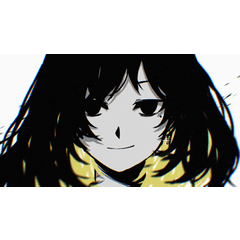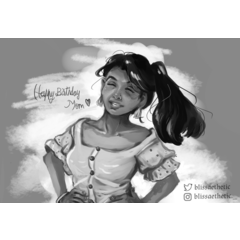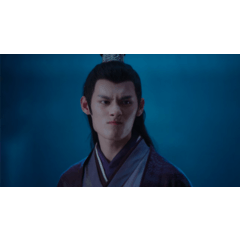Drawing faces from different angles
Drawing Faces From Different Angles.
This tutorial is about drawing the face from different angles. In this tutorial we will be going over everything there is to drawing a face. We will start with the general shape of the face and slowly go over the construction, anatomy, and features of the face. Before we continue with this tutorial please keep in mind that drawing the face is not something that's learned overnight, chances are that you won't instantly learn how to draw the face just from this tutorial, and that's okay. it's okay if you go through this tutorial multiple times, just remember to take this at your own pace, this tutorial isn't going anywhere; I would like it if you all don't rush through this guide. Remember that art takes time and that's okay, you'll probably need to look up a ton of references from websites similar to "Pinterest" if you wish to truly learn this craft. You only learn once you pick up that pencil with your own hands and try your best, you won't learn by just following tutorials and with that said I hope this tutorial helps you all!
The General Shape Of The Face.
The general shape of the face is a "box" or a rectangle, To master how to draw the face from different angles we must first learn to draw a box from different angles. The box is one of the most fundamental shapes we learn as artists and learning how to draw a box is a must-have if you wish to draw faces from literally any angle imaginable. When learning how to draw a box remember not to follow approaches similar to what you learned when you were young (approaches like drawing two boxes behind each other and connecting them) It will make your life much easier if you learn to start with a single line in any direction and build upon it to create a box.
Construction Of The Face.
1- The construction of the face is very easy. We will first start with a normal box.
2- After that, we will draw a circle inside the box, keep in mind that the circle is a little upwards and isn't completely centered in the box. This circle will define the Cranium of the head or the top of the head.
3- Once we have drawn a circle we will then draw another smaller circle to define the side of the head, remember that the head is not perfectly round and is a bit flattened from the sides. After we have drawn the smaller circle we will split it vertically and diagonally which will later help up define the other parts of the head. After that, we will split the bigger circle with a curved line from the middle to indicate the center of the face, remember that the jaw goes straight downwards from the edge of the bigger circle at around the same distance as the smaller circle. after that, we will flatten the far side of the bigger circle a bit and draw the jaw.
4- The jaw will go downwards from the middle of the smaller circle creating a 25-30 degree angle and will portray a bit downwards and inwards to the chin. Similarly, the other side will go a little down and in. We will then extend the horizontal line of the smaller circle to find the brow line. Similarly, we will then draw 2 more lines starting at the top of the smaller circle and the bottom following the curvature of the head. To define the cheeks we will draw a curved arc starting from the cross at the middle of the smaller circle and touching the jaw at the edge of the chin.
5-Once we have drawn this basic shape of the head, we can start splitting it to find the other features of the head. We will split the jaw in half to find the mouth. We can split the area between the mouth and the chin to find the location of the top half of the chin, we can split that to find the location of the lower lip. Similarly, we can split the distance between the mouth and the top of the jaw (where the line indicating the jaw shown in the image ends) to find the tip or the bottom of the nose and split that distance further in 2 to find the top lip.
Anatomy.
For the skull, I won't be going over every single bone since it's not necessary to learn about every single bone if you wish to draw the head however learning them sure does help! I have marked the important bones or landmarks that you should know about when learning to draw the head since they play a vital role in drawing the face from different angles. The 4 bones you must learn are as follows:
1- The zygomatic bone/The cheekbone (the cheekbone portrays a bit outwards and indicating this bone results in introducing structure to your drawing)
2- The mandible/ The jaw (you must learn how it's shaped and the way it rotates)
3- The nasal bone (two separate bones which provide structure to the nose and portray a bit outwards)
4- The glabella (it identifies a shift in the plane of the head from the nasal bone to the frontal bone)
I won't go into detail as to how to draw each part in perspective since it isn't necessary or as essential when drawing the face.
Drawing The Nose.
The nose mainly consists of 3 parts the Bridge, The ball, and the wings just like any other part of the human body we can break down the nose into simple shapes, Namely a triangle with an oval shape at the bottom of it. When it comes to drawing the ball we can well just break it down into a "ball shape". For drawing the nose i'll recommend you to look up references online and try breaking them down since drawing the nose is mostly just done by looking at references as everyone has a different shaped nose and its best learned by observing. Remember that the ball and the bridge are both made out of 2 separate bones and at times you'll see those both bones for example with the ball you'll see it as a small dip at the tip of the nose!
Drawing The Teeth.
Adults have in total 32 teeth inside their mouths. In total 8 incisors, 4 canines, 8 premolars and 12 molars. To draw the teeth we as always start with the general shape, the shape of the teeth is similar to a "C" shape or a curved rectangle. It is thin at the start and gets thicker as we move backward. We don't need to learn how to draw each tooth individually however, we must know what some teeth are for to draw them realistically, The incisors are mainly for cutting and are thus sharp at the ends similarly the canines are also for cutting but they are pointy making them useful when trying to cut meat. The premolars are for cutting and chewing and the molars are only for chewing. The tongue sits at the top of the mouth in a normal position. Most of the time or for most art styles we won't need to learn how to draw each tooth individually so we can just draw those teeth as the simple shape we discussed and we can then add small grooves between the incisors and the canines and the molars and the premolars to give a better sense of volume, Again if you want to learn how to draw each tooth individually my best advice for you will is to look at medical books for dentists since they show them the best.
Drawing The Ears
Often times ears might seem a little complicated but honestly, they are one of the easiest parts to draw. Features of the ear include The Helix, AntiHelix, Tragus, and Lobule. Now Drawing the ear can be broken down into 4 main steps:
1- As always we start with a box. and draw the general shape of the ear as shown above, remember to keep the lengths of each part of the ear in mind when trying to draw it. The top of the ear starts at 1/3 of the box and the bottom too starts at 1/3 of the box. Similarly, the far side on the right starts at 1/2 of the box and sharply arches inwards toward the bottom of the box, and slowly arches upwards again to the left. When drawing the ear keep in mind that just like the rest of the human body the ear is a 3D shape. As we draw heads in different perspectives remember that the ear too will rotate in different perspectives! For example, in the 2nd part, the smaller circle will also get squished as the head rotates.
2- After we have drawn the general shape of the ear we will draw a smaller circle inside the ear, again keep in mind that this circle will flatten or get squished as the head rotates in different perspectives. Make sure that the circle is close to the edge of the general shape of the ear and draw a line following the general shape of the ear on the side of the smaller circle creating a really fat looking "9" shape. After you have drawn the smaller circle you can take the top of the general shape of the ear and bring it inwards and join it at the middle of the smaller circle, This will become the starting position of the Helix.
3- Now erase the bottom of the smaller circle and the end of the Helix we just drew and draw a "Y" shape inside the ear which will become a guide for us when drawing the Antihelix.
4- now you can curve out the tips of the Helix inside the ear and join the bottom of the "Y" shape with the Lobule below make sure to add a little dip before you join it to make it look anatomically correct. Now take the top half of the "Y" shape we drew and curve it inwards, the lower one being behind the end of the starting position of the Helix and the upper part attaching to the top. The Antihelix forms a "U" shape at the top half between the top and the lower parts of the antihelix, going downwards the AntiHelix portrays outwards and goes over the Helix, slowly merging into the louble. After we have drawn the Antihelix we can draw the Tragus which is just a small wavy line indicating the start of the ear canal, the shape of the line is marked below step 4 shown on the image.
Remember that the Anti helix will portray outwards when you draw the ear at an angle and will be quite apparent. The ears are pretty forgiving when it comes to construction since their shape varies quite a lot on the person. Similarly, we can draw elf ears in the same manner too all we need to do is stretch out the Helix and Antihelix a bit.
Drawing The Eyes.
When drawing the eyes I like to start with 2 general shapes depending on the type of eye I'm drawing,
• A Box with small triangles on the sides.
• A stretched-out parallelogram.
Both these shapes give different results and their use depends on the type of character you're drawing. For me, I prefer using the box when I'm drawing eyes that are in an anime setting or when I'm drawing a character with a shocked expression. I use the Parallelogram shape when I'm drawing eyes that are for a mysterious or evil character. The shape is also best used to draw natural realistic eyes. For learning how to draw the eyes the best method I can give you all is to look up references of people and draw different eyes accordingly. Just keep in mind that the Iris of the eye is half covered by the eyelid and only shown completely when we are drawing shocked expressions. Also, keep in mind that the Pupil is inside the eye and we have something called a "lens" in front of it when drawing make sure that the pupil you're drawing is not portraying outwards.
When drawing both eyes start with a long rectangular shape, remember that the distance between the 2 eyes is equivalent to the size of one eye. Break down that box into 1/3s and draw the general shape at the ends of that box leaving the middle one empty and draw the eyes. For perspective just bend the long rectangular shape into an arch and do the same process. Also always remember that the eyes are 1/2 of the length of the nose so make sure not to exceed that.
Drawing The Hair.
Drawing hair is often mistaken as something extremely hard and it might seem hard but it's not really. Think of hair as random chaos in a confined space. As long as you stay within that space and follow along there shouldn't be any problems.
When drawing the hair I like to start with the general shape of the type of hair I'm going to draw and slowly build upon it. First, let's just start with the general shape of the hair or an outline of the general area covered by the hair. After that, we can draw a hairline, when is say the word hairline, here don't mistake it for the hairline on the forehead; Here the word hairline refers to the side where you part your hair or where most of the hair is coming out of. After the hairline is marked just slowly draw big shapes coming out from the hairline down along the general shape of the hair. I don't want you to think of hair as each individual strand but instead, as blocks or shapes overlapping each other, we can also use ribbons to draw hair! Again to look up references head over to Pinterest and look up references on hair. If you wish you can go over to my Pinterest and open the hair reference board and study from there. Download images and break down the hair into simple shapes and slowly build shapes upon them. There is also an amazing animated tutorial by Telepurte on youtube on how to draw the hair which you can look up yourself, it's around a minute long and is one of the most helpful videos I've ever seen
Link to my Pinterest for references: https://www.pinterest.com/Friendly__Neighbour/
Finally Drawing The face In Different Angles.
Finally, we will now move on to drawing the head/face at different angles, Use everything you have learned during this tutorial to help you through this, First as always start with a box. and use what we learned during the construction of the Face to build the general shape of the head. Remember that the box for the ear is the same size starting from the top of the brow line and ending just at the bottom of the eye socket. Also, remember that the ears are a little tilted and don't sit flush with the side of the head (around 25-30 degrees outwards) and construct the face! Use the knowledge you gained about the anatomy, the eyes, the ears, the nose, teeth, and the hair to the best of your abilities, and don't worry if it does not turn out the way you want it to, when we are learning new things its normal for it to not turn out the way we intend for it to the first few times and it's okay. it's normal to struggle a bit during the start since art takes time. So, don't instantly start comparing your work to the work of industry professionals since well it's obvious you won't do as good as them since they have been doing art way longer than you have. The only difference between you and an industry professional is time.
Remember to look up tons of references to help guide you while drawing the face and don't worry if your first attempts look like shit it's normal and happens to everyone just keep what you learned in this tutorial in mind and try your best!
The faces I've drawn Below are a bit exaggerated because I want to show you how I'm positioning the teeth and the jaw.
Conclusion
I hope that with these tips and tricks, you will be drawing amazing faces and be one step closer to reaching your goal. Always remember that art takes time. Sometimes it may feel like you aren't improving at all and so for those times remember to take a step back and breathe. it's okay if you don't draw for a few days. In those times maybe try learning new things or just observing new mediums just make sure not to get stuck in a single state and try your best! As always I hope this tutorial helped you all and you learned something useful from it. Take care.
Consider supporting me:
https://www.buymeacoffee.com/FriendlySaif
Link to my work:
https://friendly-neighbour.carrd.co/


















留言